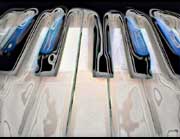Simple skip-set harmonic series tunings are generated by taking every nth member of the harmonic or subharmonic series. The lowest absolute number is called the base. For example, the twelve-tone base 11 skip 3 scale has the same harmonic relationships as the set:
11 14 17 20 23 26 29 32 35 38 41 (44) 47
44 is octave equivalent to 11, and so it is discounted. To produce a rational, octave-equivalent scale, place each member of the set over the base (times an appropriate power of two):
11 14 17 20 23 26 29 32 35 38 41 47
-- -- -- -- -- -- -- -- -- -- -- --
11 11 11 11 22 22 22 22 22 22 22 44
Then reduce them to simplest terms and order them by size:
1 23 47 13 14 29 16 17 35 19 20 41
- -- -- -- -- -- -- -- -- -- -- --
1 22 44 11 11 22 11 11 22 11 11 22
It's wise to remember to account for common factors when chosing bases. If you're skipping 2, or any power of 2, you can only generate unique scales on odd-numbered bases. Correspondingly, if you're skipping 5, or any multiple of 5, you can only generate unique scales on base numbers not divisible by 5. If your skip number is a composite, you can't generate unique scales on any base divisible by any of its factors. So, in the case of Skip 15, for example, you would avoid bases divisible by either 3 OR 5. Skipping 210, which is divisible by 2, 3, 5, and 7, you could only build unique scales on primes 11 and above, and on composites composed strictly of primes >7. But skipping 211, which is prime, you could build on every base from 2 to 210, and above that on any number not divisible by 211 -- dramatically increasing the possibilities.
How far you can carry out the idea of harmonic skip-set scales depends on practical considerations. Theoretically, the sky's the limit ([in the voice of Homer Simpson:] Stupid sky!]), but if you want to use them for musical purposes, then it's a good idea to take into account the constraints of the nature of music and of your instruments of choice. If you want 12-tone scales that fit reasonably well on a standard keyboard, you'll find that you start running out of feasible options pretty shortly after the point where the base exceeds 12*Skip. If you can handle 24-tone scales, you can build roughly twice as many usable scales per Skip. If you try extremely high Skips, you'll find that some scales contain numerous adjacent degrees too close to be discernably different in the context of the scale.
The scales below are made to fit on a standard 12-tone keyboard, +/-99c with reference to 12 EDO, except where noted.
- Skip 2
- Skip 3
- Skip 4
- 3- through 13-base
- 15- through 25-base
- 27- through 37-base
- 39- through 49-base
- Skip 5
- 2- through 8-base
- 9- through 16-base
- 17- through 23-base
- 24- through 31-base
- 32- through 38-base
- 39- through 46-base
- 47- through 53-base
- 54- through 61-base
2005 by David J. Finnamore
tuning@elvenminstrel.com
